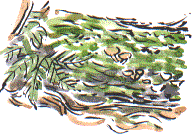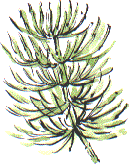Nature Diary
Rocks
History
Gallery
Links
Home Page
  A FALLEN CRACK WILLOW by the beck has sprouted groups of Honey Fungus. Below them bracket fungus is beginning to grow. The brackets are grey all-over at the moment, but I guess that this is because they are newly sprouted. They will be ringed in bands of brown when they have grown.
A FALLEN CRACK WILLOW by the beck has sprouted groups of Honey Fungus. Below them bracket fungus is beginning to grow. The brackets are grey all-over at the moment, but I guess that this is because they are newly sprouted. They will be ringed in bands of brown when they have grown.

 A fern grows beneath the moss-covered log.
A fern grows beneath the moss-covered log.
A coin-sized patch of a grey leafy lichen grows on a broken willow branch. It is probably Crottle, Parmelia saxatalis. Air pollution may have abated since the days of coal fires but West Yorkshire is still something of a lichen desert. But perhaps our air quality is steadily improving. When lichens are used as air pollution indicators 'leafy lichens on trees' would be classified as zone 4. On this scale zone 0 is at the most polluted centre of a big city and 6 the least polluted remote areas, where beard lichens would grow. Before the industrial revolution it is likely that beard lichens festooned the trees in some parts of the Calder Valley.
  A large oilseed rape field has been harvested, ploughed and today the farmer is using a seed drill and a set of rollers on it. Adult Herring Gulls are standing around, they have probably spent part of the summer on the coast. For me, gulls on ploughland is an image of autumn, so it seems strange to see Swallows alongside them, flying across the field.
A large oilseed rape field has been harvested, ploughed and today the farmer is using a seed drill and a set of rollers on it. Adult Herring Gulls are standing around, they have probably spent part of the summer on the coast. For me, gulls on ploughland is an image of autumn, so it seems strange to see Swallows alongside them, flying across the field.
 On a wide, bare slope a broad, vaguely X-shaped, pattern in the soil has been exposed. The soil colour ranges from grey, to brown to yellowish. Are these natural geological divisions? - bands of shales, sandstones and the odd coal seam. Or are they traces of human activity? - left by mining, agriculture or ancient settlement?
On a wide, bare slope a broad, vaguely X-shaped, pattern in the soil has been exposed. The soil colour ranges from grey, to brown to yellowish. Are these natural geological divisions? - bands of shales, sandstones and the odd coal seam. Or are they traces of human activity? - left by mining, agriculture or ancient settlement?
 Growing by the towpath, there's a plant which always confuses me. It's a Potentilla but is it the common weed Creeping Cinquefoil, Potentilla reptans, which gets its name because it has five petals, backed by five sepals and leaves divided into five sections?
Growing by the towpath, there's a plant which always confuses me. It's a Potentilla but is it the common weed Creeping Cinquefoil, Potentilla reptans, which gets its name because it has five petals, backed by five sepals and leaves divided into five sections?
 A few of the flowers have five petals but most of them have four, arranged in a cross-shape. This makes me think it is Tormentil, Potentilla erecta, a related plant which grows on heaths and moors. If in doubt, a botanist would simply record this plant as Potentilla sp., an unidentified species of Potentilla.
A few of the flowers have five petals but most of them have four, arranged in a cross-shape. This makes me think it is Tormentil, Potentilla erecta, a related plant which grows on heaths and moors. If in doubt, a botanist would simply record this plant as Potentilla sp., an unidentified species of Potentilla.
Field Horsetail grows to a foot or so high, on the dry grassy verge and under the hawthorn hedge. I've been drawing horsetails recently, in the backgrounds to a series of dinosaur illustrations. Like the ruling reptiles, some of the horsetails grew on a larger scale in those days.

Richard Bell,
wildlife illustrator
E-mail; 'richard@daelnet.co.uk'
Next day
Previous day
Nature Diary
Wild West Yorkshire home page
|

 A FALLEN CRACK WILLOW by the beck has sprouted groups of Honey Fungus. Below them bracket fungus is beginning to grow. The brackets are grey all-over at the moment, but I guess that this is because they are newly sprouted. They will be ringed in bands of brown when they have grown.
A FALLEN CRACK WILLOW by the beck has sprouted groups of Honey Fungus. Below them bracket fungus is beginning to grow. The brackets are grey all-over at the moment, but I guess that this is because they are newly sprouted. They will be ringed in bands of brown when they have grown.
 A fern grows beneath the moss-covered log.
A fern grows beneath the moss-covered log.
 A large oilseed rape field has been harvested, ploughed and today the farmer is using a seed drill and a set of rollers on it. Adult Herring Gulls are standing around, they have probably spent part of the summer on the coast. For me, gulls on ploughland is an image of autumn, so it seems strange to see Swallows alongside them, flying across the field.
A large oilseed rape field has been harvested, ploughed and today the farmer is using a seed drill and a set of rollers on it. Adult Herring Gulls are standing around, they have probably spent part of the summer on the coast. For me, gulls on ploughland is an image of autumn, so it seems strange to see Swallows alongside them, flying across the field. On a wide, bare slope a broad, vaguely X-shaped, pattern in the soil has been exposed. The soil colour ranges from grey, to brown to yellowish. Are these natural geological divisions? - bands of shales, sandstones and the odd coal seam. Or are they traces of human activity? - left by mining, agriculture or ancient settlement?
On a wide, bare slope a broad, vaguely X-shaped, pattern in the soil has been exposed. The soil colour ranges from grey, to brown to yellowish. Are these natural geological divisions? - bands of shales, sandstones and the odd coal seam. Or are they traces of human activity? - left by mining, agriculture or ancient settlement? Growing by the towpath, there's a plant which always confuses me. It's a Potentilla but is it the common weed Creeping Cinquefoil, Potentilla reptans, which gets its name because it has five petals, backed by five sepals and leaves divided into five sections?
Growing by the towpath, there's a plant which always confuses me. It's a Potentilla but is it the common weed Creeping Cinquefoil, Potentilla reptans, which gets its name because it has five petals, backed by five sepals and leaves divided into five sections? A few of the flowers have five petals but most of them have four, arranged in a cross-shape. This makes me think it is Tormentil, Potentilla erecta, a related plant which grows on heaths and moors. If in doubt, a botanist would simply record this plant as Potentilla sp., an unidentified species of Potentilla.
A few of the flowers have five petals but most of them have four, arranged in a cross-shape. This makes me think it is Tormentil, Potentilla erecta, a related plant which grows on heaths and moors. If in doubt, a botanist would simply record this plant as Potentilla sp., an unidentified species of Potentilla.